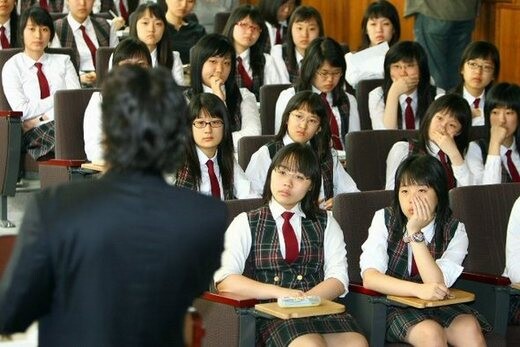hankyoreh
Links to other country sites 다른 나라 사이트 링크
Private spending on education No. 1 in Korea

South Korean private spending on public and private education was the highest among advanced countries, with college costs ranking at fourth highest, according to a report compiled by the Organization of Economic Cooperation and Development (OECD).
The report issued the rankings based on the ratio of private educational spending to total GDP.
The report showed 2.9 percent of total gross domestic product (GDP) amounted to educational spending by the private sector, the highest among countries surveyed. However, this figure did not include tuition for private tutoring or academic institutes, which would no doubt push the figure much higher, experts noted.
The corresponding figure for the education of elementary and middle school students in Korea stood at 0.9 percent, compared with the average of 0.3 percent among advanced countries. The gap widens further when it comes to high school and college students, as educational spending increases significantly in those age groups. This is likely due to the fact that 60 percent of Korean students attend private universities, which are more expensive than their public counterparts.
Average tuition for public universities in South Korea was US$3,623 and for private universities US$6,953, according to the report. Measured in pure dollar amounts, Australia topped the list in terms of college tuition, followed by the U.S. and Japan. South Korea came in fourth.
There was some good news for Korean parents in the OECD report. Based on purchasing power parity, education spending in South Korea translated into US$4,098 for elementary school students, and the corresponding figure for middle and high school students was US$6,410 and US$7,089, respectively, all much lower than the OECD average.
Additionally, the OECD report showed that South Korean private and public sectors spent a total 7.5 percent of its GDP on education, higher than the 5.9-percent average among the 30 OECD member countries and four non-member nations, including Russia.
Editorial・opinion
![[Column] Park Geun-hye déjà vu in Yoon Suk-yeol [Column] Park Geun-hye déjà vu in Yoon Suk-yeol](https://flexible.img.hani.co.kr/flexible/normal/500/300/imgdb/original/2024/0424/651713945113788.jpg) [Column] Park Geun-hye déjà vu in Yoon Suk-yeol
[Column] Park Geun-hye déjà vu in Yoon Suk-yeol![[Editorial] New weight of N. Korea’s nuclear threats makes dialogue all the more urgent [Editorial] New weight of N. Korea’s nuclear threats makes dialogue all the more urgent](https://flexible.img.hani.co.kr/flexible/normal/500/300/imgdb/original/2024/0424/7317139454662664.jpg) [Editorial] New weight of N. Korea’s nuclear threats makes dialogue all the more urgent
[Editorial] New weight of N. Korea’s nuclear threats makes dialogue all the more urgent- [Guest essay] The real reason Korea’s new right wants to dub Rhee a founding father
- [Column] ‘Choson’: Is it time we start referring to N. Korea in its own terms?
- [Editorial] Japan’s rewriting of history with Korea has gone too far
- [Column] The president’s questionable capacity for dialogue
- [Column] Are chaebol firms just pizza pies for families to divvy up as they please?
- [Column] Has Korea, too, crossed the Rubicon on China?
- [Correspondent’s column] In Japan’s alliance with US, echoes of its past alliances with UK
- [Editorial] Does Yoon think the Korean public is wrong?
Most viewed articles
- 1‘We must say no’: Seoul defense chief on Korean, USFK involvement in hypothetical Taiwan crisis
- 2N. Korean delegation’s trip to Iran shows how Pyongyang is leveraging ties with Moscow
- 3‘Weddingflation’ breaks the bank for Korean couples-to-be
- 4[Column] Park Geun-hye déjà vu in Yoon Suk-yeol
- 5Korea sees more deaths than births for 52nd consecutive month in February
- 6[Guest essay] The real reason Korea’s new right wants to dub Rhee a founding father
- 7[Column] The clock is ticking for Korea’s first lady
- 8[Column] Has Korea, too, crossed the Rubicon on China?
- 9Why Korea shouldn’t welcome Japan’s newly beefed up defense cooperation with US
- 10Will NewJeans end up collateral damage in internal feud at K-pop juggernaut Hybe?